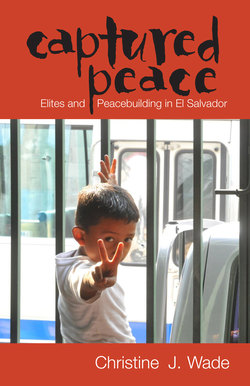Captured Peace

Реклама. ООО «ЛитРес», ИНН: 7719571260.
Оглавление
Christine J. Wade. Captured Peace
Отрывок из книги
Captured Peace
This series of publications on Africa, Latin America, Southeast Asia, and Global and Comparative Studies is designed to present significant research, translation, and opinion to area specialists and to a wide community of persons interested in world affairs. The editors seek manuscripts of quality on any subject and can usually make a decision regarding publication within three months of receipt of the original work. Production methods generally permit a work to appear within one year of acceptance. The editors work closely with authors to produce high-quality books. The series is distributed worldwide. For more information, consult the Ohio University Press website, ohioswallow.com.
.....
Rather than subside, however, the levels of violence increased. Death squads and right-wing paramilitary groups began “disappearing”73 those associated with labor unions, peasant groups, the church, and students. Between 1980 and 1982, approximately forty-two thousand people were killed by police, military, and paramilitary death squads.74 More than thirteen thousand people were murdered or disappeared in 1980 alone, most of them peasants, workers, and students.75 Innocent civilians, including children, were frequently caught in the military’s “low-intensity,” counterinsurgency strategy. Numerous massacres of civilians, including those at the Sumpul River, El Mozote, the Lempa River, El Calabozo, and the Gualsinga River, demonstrated the brutality of government forces. At El Mozote, more than seven hundred unarmed civilians, including infants and children, were summarily executed.76 One of the most frequent perpetrators of the massacres was the “elite” U.S.-trained Atlacatl Batallion, which was widely regarded as “the most efficient killing machine that the Salvadoran army had to offer.”77
A series of high-profile assassinations in 1980 effectively ended any prospect for a peaceful settlement to the conflict. Archbishop Óscar Arnulfo Romero was assassinated while celebrating mass on March 24, 1980. Although initially thought to be a conservative Vatican appointment, Romero was radicalized by the overwhelming violence in El Salvador, particularly the attacks on priests and the murder of his good friend Rutilio Grande. During the three years that Romero was the archbishop of San Salvador, he implored government forces, paramilitary death squads, and revolutionaries to lay down their weapons. His powerful sermons on themes of social justice, impunity, repression, and poverty made him the “voice of the voiceless.” They also made him a threat to elites. The month before his assassination, Romero wrote a letter to U.S. president Jimmy Carter asking him to prohibit military aid. So compelling was his presence that many combatants would later say that his assassination drove them to join the revolution.78 Six leaders of the opposition Democratic Revolutionary Front (FDR), including the organization’s president, Enrique Álvarez Córdova, were abducted, tortured, and murdered in November 1980 by security forces as they gathered for a press conference.79 The remaining leadership was forced into exile. Weeks later, in December 1980, three American nuns and a layworker were abducted, raped, and murdered by members of the National Guard. Three days later the bodies of Maura Clarke, Ita Ford, Dorothy Kazel, and Jean Donovan, who served as a pallbearer at Romero’s funeral, were found buried in a single shallow grave. These deaths shocked Salvadorans and the international community and convinced many that the space for political settlements had closed.
.....